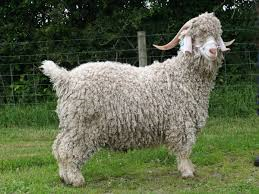Type the name of the breed you're looking for below
[wpdreams_ajaxsearchlite] Don't see the breed your're looking for? Click here and let us know!
Angora goat
| Place of Origin | Turkey |
| Origin | The Angora goat is a breed of domestic goat that is named for Ankara, Turkey, historically known as Angora. Angora goats produce the lustrous fibre known as mohair. The Angora goat originated in the district of Angora in Asia Minor. The Angora dates back prior to early biblical history. Mention is made of the use of mohair at the time of Moses, which would fix the record of the Angora some time between 1571 and 1451 B.C. Mohair became a valuable product in commerce early in the nineteenth century. In order to increase the supply of mohair available for export to the European countries, the Turks crossed the Angora goat with common stock to increase the poundage of salable hair. Probably there was no effort to keep the original Angora separate, and the general increase in size and vigor of the goats in the Angora area was, no doubt, partially the result of this infusion of other blood. Angora stock was distributed to different countries, and a pair of Angoras was imported to Europe by Charles V about 1554. In 1765 an importation was made by the Spanish government and twenty years later a considerable number were imported into France. None of these importations were successful in establishing mohair production. On the other hand, Angoras were taken to South Africa in 1838, and from this importation and later importations mohair production was established in that country. The Union of South Africa is one of the three leading mohair-producing sections in the world and is exceeded in production only by the United States and Turkey. |
| Purpose | Fiber |
| Characteristics | The Angora is very picturesque animal in which both sexes are horned. The bucks usually have a pronounced spiral to the horn, which comes back and away from the head; the horns of mature bucks sometimes reach two or more feet (60 cm) in length . In contrast, the horn of the female is comparatively short, much smaller, and has only a very slight tendency to spiral. The horn of the female seldom exceeds nine or ten inches (25 cm). The ears are heavy and drooping. For a long time, Angora goats were bred for their white coats. In 1998, the Coloured Angora Goat Breeders Association was set up to promote breeding of coloured Angoras. Now, Angora goats produce white, black (deep black to greys and silver), red (the colour fades significantly as the goat gets older), and brownish fibers. The Angora goat is a small animal as compared to sheep, common goats, or milk goats. There is considerable variation in the size of goats, but mature bucks will usually fall in a weight range of from 180 to 225 pounds (80-100 kg) but do not reach their maximum weight until after five years of age. Does will fall in a weight range of from 70 to 110 pounds (30-50 kg) when mature. The form of the goat should be similar to that of sheep, but the mutton characteristics are much less developed. The back should be straight, the rib well sprung, and the body deep and uniform in depth. The chest should be wide, the legs straight, and the rear quarters should show ample development. |
| Other Considerations | The fleece taken from an Angora goat is called Mohair. A single goat produces between four and five kilograms (10 lb) of hair per year. Angoras are shorn twice a year. Angoras, despite their coats, bear no relation to sheep. Turkey, Argentina, the United States, and South Africa are the top producers of mohair. Secondary producers include New Zealand and Australia. Angora goats are more susceptible to external parasites (ectoparasites) than similar animals, as their coats are denser. They are not prolific breeders, nor are they considered very hardy, being particularly delicate during the first few days of life. Further, Angoras have high nutritional requirements due to their rapid hair growth. A poor-quality diet will curtail mohair development. |



